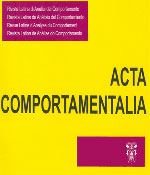Conditional relations between known words
DOI:
https://doi.org/10.32870/ac.v4i1.18274Keywords:
Conditional discrimination, contextual control, stimulus equivalence, college students.Abstract
The objective of this study was to investigate the emergence of untrained conditional relations among words that were members of culturally trained classes before the experiment. Subjects were 4 college students. In Condition A three equivalence classes of names of personalities (businessmen, athletes, ecologists) with three members each were formed through conditional discrimination training. Each class had a name from each of three geographic regions of Brazil (North, Northeast, Southeast). Matching-to-sample tests were then presented with three names of personalities of the same professional category but from different geographic regions as samples, and three names of personalities of the same professional category, but from different geographic regions, as comparisons. The relation by region did not emerge. In Condition B, the subjects were submitted to the same training procedure. The tests had three names of personalities of the same professional category, but from different geographic regions, as samples, and three names of cities, also from different geographic regions as comparisons. The relation by regíon did emerge. Subjects were then re-exposed to Condition A, now showing positive results in tests. Therefore, the history of emergence of conditional relations by region in Condition B was necessary for the emergence of conditional relations by region among names of personalities, providing the context for matching the names to sample by geographic region, after training of matching by profession.
Downloads
Downloads
How to Cite
Issue
Section
License

<a rel="license" href="http://creativecommons.org/licenses/by-nc-sa/4.0/"><img alt="Licencia de Creative Commons" style="border-width:0" src="https://i.creativecommons.org/l/by-nc-sa/4.0/88x31.png" /></a><br />Este obra está bajo una <a rel="license" href="http://creativecommons.org/licenses/by-nc-sa/4.0/">licencia de Creative Commons Reconocimiento-NoComercial-CompartirIgual 4.0 Internacional</a>.






